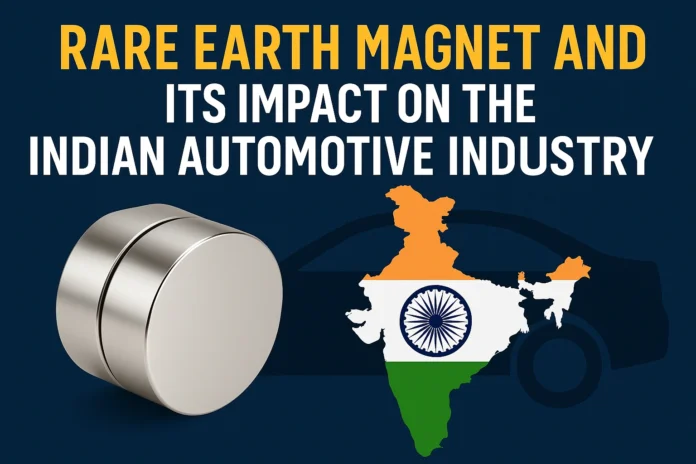In the age of electrification and technological innovation, rare earth magnets have emerged as a critical component of the automotive industry—especially in electric vehicles (EVs), hybrid systems, and advanced driver-assistance systems (ADAS). While the term may sound exotic, rare earth magnets are increasingly becoming the backbone of India’s mobility transformation.
This article explores what rare earth magnets are, how they’re produced, and the transformative role they play in shaping the future of Indian automobiles.
🔩 What Is a Rare Earth Magnet?
Rare earth magnets are powerful permanent magnets made from rare earth elements, a group of 17 chemically similar elements found in the periodic table. The two most commonly used types in industry are:
-
Neodymium Iron Boron (NdFeB) Magnets
-
Samarium Cobalt (SmCo) Magnets
Neodymium magnets, the most widely used, are known for their extreme strength, light weight, and thermal stability, making them ideal for compact, high-efficiency applications.
📘 Key Properties:
-
Strongest type of permanent magnet available
-
Retains magnetism under heat and mechanical stress
-
Enables miniaturization of motors and electronics
-
Long lifespan and resistance to demagnetization
🔧 How Are Rare Earth Magnets Used in Automobiles?
In modern vehicles—especially EVs and hybrids—rare earth magnets are used in multiple components, including:
1. Electric Motors (EV & Hybrid Cars)
-
Neodymium magnets are central to Permanent Magnet Synchronous Motors (PMSMs) used in EVs.
-
They help deliver higher torque and better energy efficiency compared to induction motors.
2. Power Steering Systems (EPS)
-
EPS systems powered by compact motors rely on rare earth magnets to reduce steering effort.
3. ABS & ADAS Sensors
-
High-precision sensors for braking, lane detection, and auto-parking use rare earth magnets for accurate positioning and feedback.
4. Start-Stop Mechanisms
-
In fuel-efficient vehicles, start-stop systems use magnetic sensors to quickly restart engines.
5. Speakers & Infotainment
-
Premium sound systems in cars often use neodymium-based speaker magnets for lightweight, high-fidelity audio.
🇮🇳 The Role of Rare Earth Magnets in India’s Automotive Transformation
India’s auto sector is in the middle of a clean-tech revolution. The government’s push for EV adoption, through policies like FAME II, PLI schemes, and zero-emission targets, makes rare earth magnets a strategic resource.
💡 Why Rare Earth Magnets Matter to India:
-
EV Manufacturing Boom
-
India is rapidly expanding its EV production. Every EV motor uses rare earth magnets, especially NdFeB, which boosts motor efficiency and range.
-
-
Make-in-India Push
-
The government aims to localize critical components. Manufacturing rare earth magnets domestically can reduce import dependency from China.
-
-
Reducing Vehicle Weight
-
Lightweight, high-power magnets reduce the overall weight of vehicles, improving fuel efficiency and extending battery range in EVs.
-
-
Tier 1 & 2 Supplier Ecosystem
-
Indian component manufacturers are integrating rare earth magnets into BLDC motors, actuators, cooling fans, and HVAC systems, giving rise to a robust supply chain.
-
🏭 Rare Earth Magnet Production: India’s Challenges and Opportunities
🔍 Current Scenario:
-
India has abundant rare earth mineral reserves, especially in coastal regions and states like Andhra Pradesh, Tamil Nadu, and Odisha.
-
However, refining, separation, and magnet production technologies are still nascent.
-
Most of the magnet-grade rare earths are imported, primarily from China, which controls over 80% of global rare earth processing.
🌱 Government Initiatives:
-
Indian Rare Earths Ltd (IREL) and other PSUs are exploring domestic refining capacity.
-
Collaboration with Japan and Australia for technology transfer is underway.
-
The PLI scheme for Advanced Chemistry Cell Batteries also supports rare earth magnet usage in EVs.
🌏 Global Context and India’s Strategic Position
China’s Dominance:
China has developed a vertically integrated rare earth industry—from mining to magnet fabrication. This poses a strategic risk to India, which needs to diversify supply chains and build self-reliance.
India’s Opportunity:
India is one of the few countries with raw material reserves, a growing auto market, and manufacturing ambition. This puts India in a position to:
-
Become a hub for rare earth magnet production
-
Reduce EV production costs
-
Boost export potential in the global auto supply chain
🔄 Case Studies: Rare Earth Magnet Impact on Indian Auto Brands
⚡ Tata Motors
-
With the launch of Tata Nexon EV and Tigor EV, Tata uses PMSM motors embedded with rare earth magnets, improving range and efficiency.
🛻 Mahindra Electric
-
In e-Verito and XUV400, magnet-based motors offer quieter operation and high torque at low RPMs—essential for urban driving.
🚗 Maruti Suzuki
-
Partnering with Toyota for hybrid tech, which heavily relies on magnet-driven motors in their upcoming strong-hybrid vehicles.
Read More: influencersgonewild
💬 3 Most Asked FAQs About Rare Earth Magnets in Indian Auto Industry
Q1. Are rare earth magnets available in India?
A: Yes, India has rare earth mineral reserves, but currently lacks full-scale refining and magnet-making capacity. Most high-grade magnets are still imported.
Q2. Why are rare earth magnets used in EVs?
A: They offer high power density, low weight, and high efficiency, making them ideal for compact electric motors that power EVs and hybrids.
Q3. Will India become self-sufficient in rare earth magnet production?
A: With growing government focus, tech partnerships, and private sector investment, India is likely to build end-to-end capacity within this decade.
🚀 Final Thoughts
Rare earth magnets may be invisible inside a vehicle, but they’re driving the future of automotive innovation. From powering motors to enabling smarter systems, these small components hold massive potential—especially for a country like India, poised to lead the global shift toward sustainable mobility.
To ensure success, India must scale domestic refining, magnet fabrication, and R&D while strategically integrating rare earth tech into its growing auto sector.
In a world chasing electric dreams, rare earth magnets are the unseen force steering India forward.
Read More:

